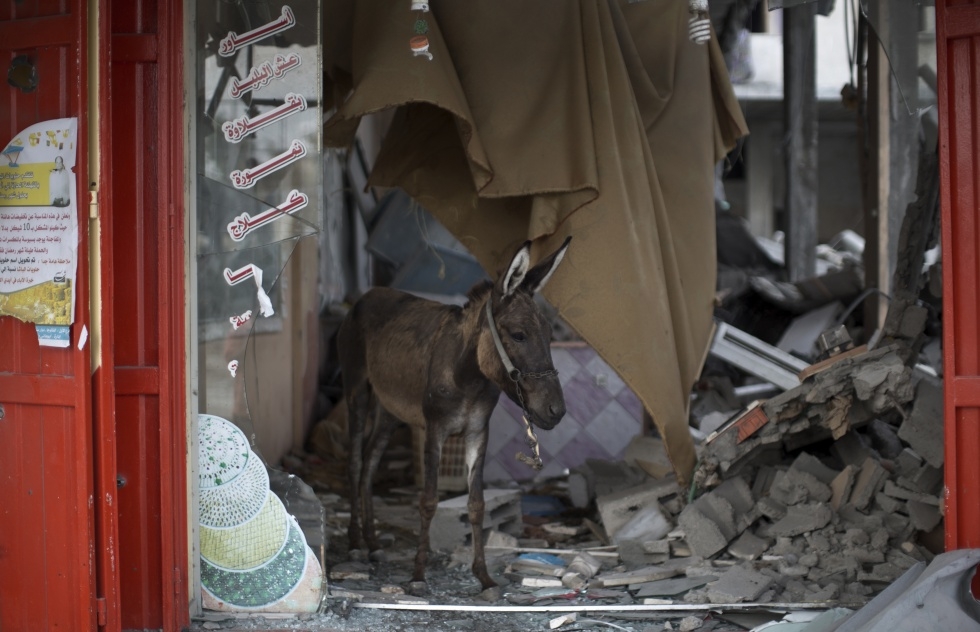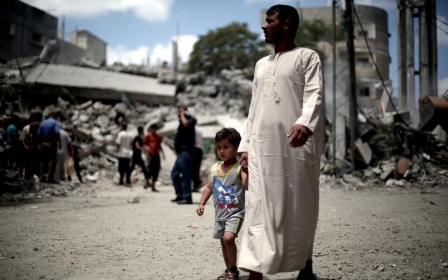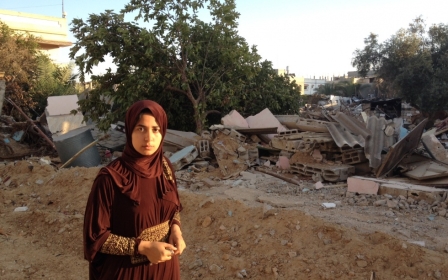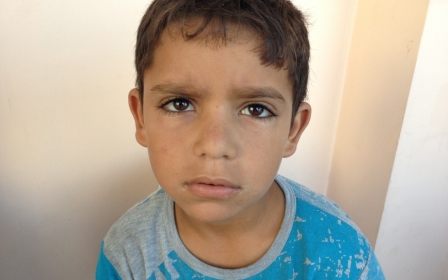Not even animals are safe in Gaza

KHAN YUNIS- “We are not one of those luxury states, we are simple farming people who use a few donkeys a lot, in our lives, and always have.”
Ali Alommor, 34-years old, is a Palestinian who relied on his donkeys for farming. Now they are dead; killed by Israeli air-strikes. His house still stands, but his donkeys are all dead.
One donkey is riddled with bullets; another looks like a bulldozer ran over it while it tried to escape. Alommor had to flee his home, at Israeli gunpoint, seeking any safe shelter that he could find for his wife and children.
His farm looks like it’s been hit by an earthquake and he still can’t fathom why Israel should be so desperate to target animals, destroy agriculture and Gaza’s farming products.
“We escaped almost-certain death, leaving camels, donkeys, cows and birds - the tank shells hit the trees, the stones and even the animals,” he said as he inspected the massive damage caused to his crops, surrounded by the stench of the decaying flesh of the dead animals around him.
Alommor lives in an agricultural area, and he, as well as many of his neighbours also sustained massive damage to property. Now, no bulldozers can reach the area to clear the rubble. There are still bodies of four missing people that are believed to be decaying under the rubble. No one knows which building they could be in.
“We are used to being invaded by Israeli troops, as we live close to Israel’s fence around us - this is an area which does not receive much media attention - despite Israeli special forces invading once or twice, weekly,” he said.
He acknowledged that animals which were lucky enough to avoid Israeli missiles or bulldozers on the farm eventually died from starvation; food and water were unavailable when the family had to escape their home.
“Israeli troops shoot at anything that moves, even when they can see it’s only a camel, donkey or chicken, kept outdoors in the summer, meaning animals are very visible.”
He shared how he saw his neighbours dog hit directly by an Israeli drone missile, blowing it into tiny pieces. Medical specialists in Gaza said that leaving these dead animals to decay among agricultural crops would cause human contamination and a long-term environmental crisis.
36-year old Sami Abu Hadaeid, had no other option but to run away when tank shells began falling on his land, but he grieved leaving his 30 sheep behind. When the five-day ceasefire was announced, he returned to his home.
He arrived home to witness that all 30 sheep had been savagely killed.
“I wish I knew they hadn’t suffered,” but his brother and neighbours doubt this. Some were riddled with bullet holes. One had its head sliced off, and all were covered with flies and worms - among more dead animals lying around were some killed by tiny shrapnel wounds. All were dead - others not physically wounded, they probably died from fear, hunger and thirst, with the land destroyed around them, polluted water and Israeli bulldozers demolishing everything in sight. Other neighbours have seen the same injuries in their dead animals.
“Come see inside, some are even buried under a pile of bulldozed farm sand - I left them alive, now they’re all dead.”
Abu Hadaeid walked to the other side of his farm to find more sheep flattened by bulldozers - “You feel very sad to see an animal you raised and cared for, for years, slaughtered like this. Imagine how it feels to lose a brother,” he said, while following the tracks of the bulldozer as it flattened his land and whatever animals stood in the way.
He dug out more animals over the next few hours - ones which were unable to escape. “I doubt whether I’ll find any more alive.” he said. The financial loss is estimated at around $12,000.
He walked over to massive rows of cactus plants, all broken and crushed - the Israeli bulldozers seem to have avoided using streets, expecting explosive devices, so the only route for the bulldozers was straight through farms and homes to get to roads.
He continued walking through his farm - bulldozers came right through rooms, on top of mattresses, furniture, and even flattening a teapot and fireplace.
One of his neighbours arrived to see the farm - or rather what was left of it - sheep carcasses and destruction only.
“This sheep belonged to another farm nearby, now its lying dead here.” he said.
Israel’s bombardment also hit the Gaza municipality zoo of Isaad al-Tifola - where several animals were killed. Mohammed Abu Ajwwa, 37, looked at his dead cows, “Even they paid the price of Israel’s attacks.” he said, while inspecting damage during the ceasefire.
“Israeli tank shells killed over 500 of our cows, all of which supplied the Gaza market with milk.” he said. 60 of his family members make their living breeding dairy cows.
He tried to get the cows to a safe place when he saw smoke coming out of places near his farm in Shejaiya. His loss is estimated at around $500,000. Meanwhile, the ministry of agriculture says it can’t reach all areas to account for the damage unless the longer ceasefire holds.
The uncle of Sami, Hamad Abu Hadaeid, 80-years old, sustained even more damage than his nephew - for years he has taken care of his dairy and beef cattle and made his living doing so.
“It is appalling that even sheep are slaughtered by Israeli machines,” he said, giving thanks for one small miracle - his donkey survived the air strikes.
“My donkey must have been terrified - his behaviour has changed - he’s nervous and just wants to run away from here,” he said.
He mentioned animal-rights groups - “if the abuse of our human rights is not condemned by the world, then I hope at least animal-rights groups will have something to say about this.”
New MEE newsletter: Jerusalem Dispatch
Sign up to get the latest insights and analysis on Israel-Palestine, alongside Turkey Unpacked and other MEE newsletters
Middle East Eye delivers independent and unrivalled coverage and analysis of the Middle East, North Africa and beyond. To learn more about republishing this content and the associated fees, please fill out this form. More about MEE can be found here.




